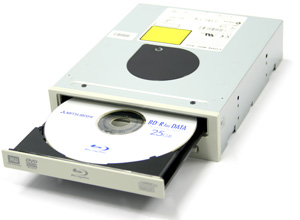News Release’╝ÜSuccess in the use of Organic Dye Recording Film in Blu-ray Recordable Discs--- Conforming to Blu-ray Disc Recordable Format Ver.1.2 ---Developing Technology for Recordable Blu-ray Discs with Metal Nitride Film
Information contained in the news release is current as of the date of announcement.
It is subject to change without prior notice.
Pioneer Corporation
Mitsubishi Kagaku Media Co., Ltd.
Success in the use of Organic Dye Recording Film in Blu-ray Recordable Discs
--- Conforming to Blu-ray Disc Recordable Format Ver.1.2 ---
Developing Technology for Recordable Blu-ray Discs with Metal Nitride Film--- Capable of Multiple-Layered, High Speed Recording ---
Pioneer Corporation (Head Office: Meguro-ku, Tokyo; President: Tamihiko Sudo) and Mitsubishi Kagaku media Co., Ltd. (Head Office: Minato-ku, Tokyo; President: Shigenori Otsuka) have together succeeded in commercialization of recordable Blu-ray Discs (BD-R) with organic dye in the recording layer, and also in developing technology for multiple layered, high speed recording for BD-R with metal nitride in the recording layer.
BD-R with Organic Dye Recording Film
Both companies had been collaborating to develop BD-R with dye since 2004. With this development, Mitsubishi Kagaku Media was responsible for improving organic dye recording materials and producing sample discs, while Pioneer was responsible for evaluating the samples, as well as disc structure design based on verification and simulations for compatibility with disc drives. The synergy of these two areas of expertise has led to a successful development of the 2X organic dye BD-R.
Since the announcement*1 of the joint development in 2005, Mitsubishi Kagaku Media and Pioneer have also been promoting the standardization of organic dye recording media, and this spring, a recording format (Low to High Type format) for organic dye BD-R has been adopted into the BD-R Format Ver. 1.2*2.
With this standardization, the mass production of organic dye recording media has now become possible with BD-R. Discs with organic dye do not require large-scale investments in facilities so that the current coating facilities for CD-R and DVD-R can be used for BD production lines with only minor adjustments, making low priced discs a possibility.
BD-R Discs with Metal Nitride Film
Further, the development of high performance BD-R with double to multiple layered and high speed recording capability by using metal nitride has been pursued, and technology required for these multiple layered, high speed recording has been successfully developed.
Pioneer is the holder of the basic patent for the recording film, and has made many presentations at symposium such as ISOM*3 up to 2006. Additionally, Mitsubishi Kagaku Media has commenced the sale of the discs with this recording film as 2X BD-R as of July 2006.
Future Developments
Both companies will continue to improve specifications of BD-R with organic dye and metal nitride, and to contribute to the further development of the Blu-ray system by applying the technology on high speed recording, double layered media, and so on.
The development results will be on display at CEATEC JAPAN 2007 in the Pioneer Corporation booth and the BDA*4 booth from October 2 at Makuhari Messe.
[Terminology] Low to High Type (LTH TYPE)
A laser beam causes the chemical and physical changes in the nature of the recording media where it hits when recording data onto optical discs. The data can be read utilizing the difference in optical reflectance between those sections that are changed and those that aren't. The optical reflectance prior to recording is low and that of after recording is high in the media with organic dye.
Additionally, for BD-R using the metal recording media currently in the market, a method is applied which makes the optical reflectance of the recorded section lower than that prior to recording (High to Low Type).

Photo-1: BD-R disc with Organic Dye Recording Film (prototype)

Photo-2: BD-R disc with Metal Nitride Recording Film and
BD drive supporting both of the above discs (prototype)
Search for Other resources
Search for Keyword
Search by date
-
December 1, 2025ManagementPioneer Announces Completion of Shareholder Transition

-
June 26, 2025ManagementAnnouncement of Shareholder Change

-
May 9, 2025ManagementPioneer Announces Executive Appointments

-
April 1, 2025ManagementPioneer Appoints Werner Koestler as Executive Fellow
as Part of Driving Growth of Its Business in Global Markets
-
March 28, 2025ManagementPioneer to Begin Manufacturing In-Car Products in India
A strategic initiative to better serve local automakers
and drive the growth of its global business
-
February 6, 2025ManagementPioneer Launches R&D Operations in Germany
to bolster its car electronics business with European automakers
-
December 5, 2024ManagementPioneer and HERE join forces on connected mobility solutions, beginning with two-wheelers

-
December 2, 2024ManagementPioneer Announces Organization and Management Changes

-
August 29, 2024ManagementPioneer and ZENRIN Expand Partnership to Address Industrial Mobility Issues
Jointly developing and offering a broad range of DX solutions and services to business operators in diverse industries
-
July 22, 2024ManagementPioneer submits commitment letter to SBTi

